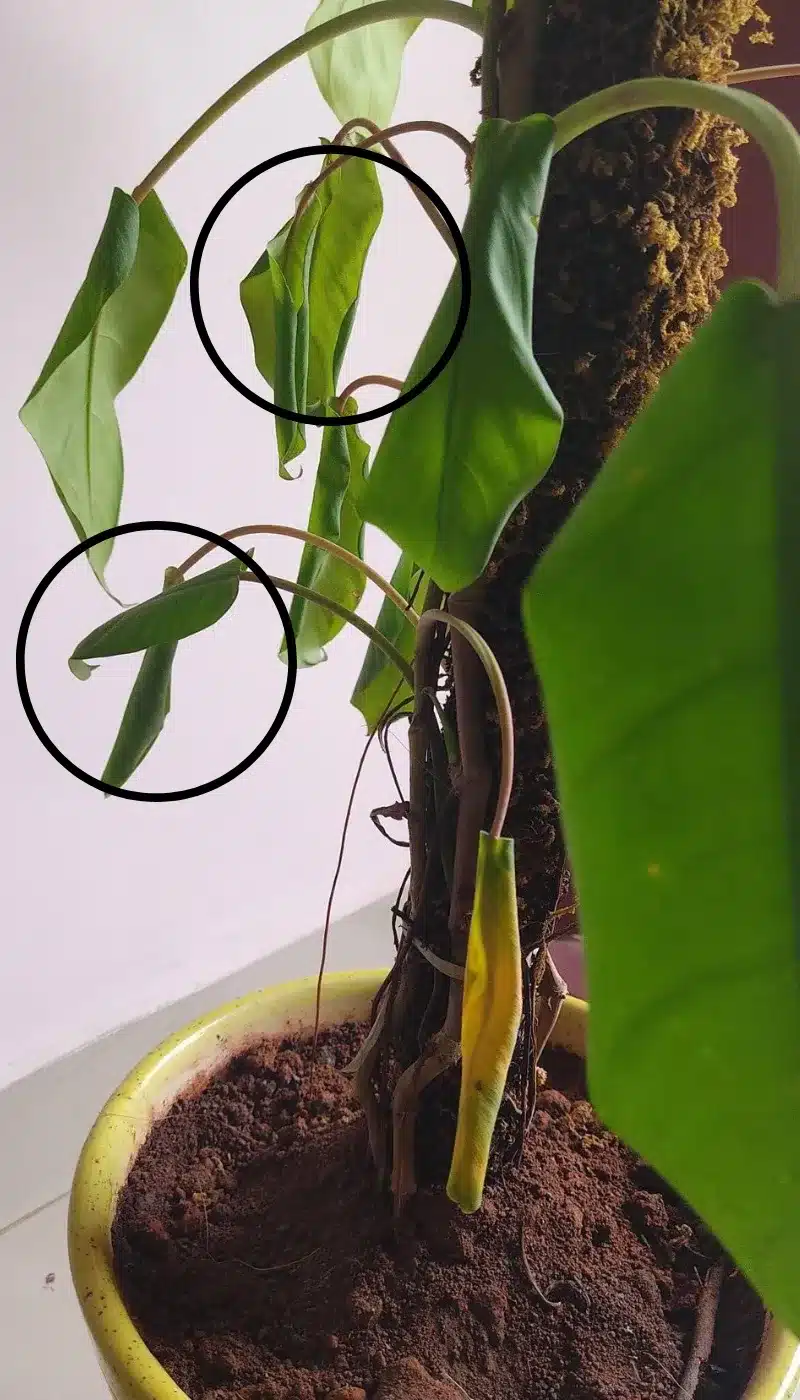Usually a tough tropical native, a drooping Philodendron may indicate that the plant is bowing down to a series of environmental outturns.
It’s normal if Philodendron faces drooping and curling issues after repotting due to transplant shock, as the plant becomes normal after some time.
So, go through this entire article if your Philodendron is drooping due to other reasons to fix the problem as soon as possible.
Table of Contents Show
5+ Possible Reasons Behind Drooping Philodendron
Drooping is a common issue that can occur in any Philodendron variety like Philodendron verrucosum, birkin, selloum, split-leaf, or heartleaf Philodendron.
1. Improper Watering
Improper watering, including overwatering and underwatering, is the major cause of drooping and wilting philodendrons.
Due to underwatering, plants lose the water inside them, shrinking the cell wall, which causes low turgor pressure.
As a result, Philodendron starts showing symptoms like slow growth and crispy brown leaf edges following droopy and curling leaves.

Furthermore, overwatering may also cause drooping leaves due to excessive water absorption, creating photosynthesis blockage.
Thus, you must water your Philodendron daily only when the soil is completely dry during the growing season.
Even if you water properly, bad water quality may also cause droopy leaves leading to the death of the plant in severe cases.
2. Sunlight Issues
Your Philodendron may face drooping leaves when you place it in an area with direct sunlight or with no light.
Too high sunlight may cause the yellow or discolored leaves that gradually droop if the condition persists.
Likewise, too low sunlight may cause darker-shaded leaves that eventually wilt due to low photosynthesis causing droopy leaves.
Generally, Philodendron needs 4-6 hours of bright indirect sunlight daily to remain their beautiful leaves healthy.
3. Incorrect Temperature
Excessive heat, cold, or drafts may also be the reasons behind your drooping Philodendron, as such a condition damages the cell wall.
Too much heat dehydrates the plant causing symptoms like curled and droopy leaves that shed as the condition continues.
Moreover, temperatures below 50°F will cause stunted growth and loosened roots before drooping the leaves.
Thus, you must maintain the optimal temperature of 75 to 85 °F at daytime and 65 to 70 °F during the night for your Philodendron.
4. Fertilizer Problems
Excessive or too low fertilizer is also the reason behind droopy, wilted, or Philodendrons with limp leaves.
Due to inadequate fertilizer, your Philodendron may face stunted growth with yellow and droopy leaves.
Also, the plant may suffer from burning foliage, dehydration, and excessive salt buildup in the soil resulting in drooping leaves.
Philodendron needs a balanced fertilizer monthly for healthy green foliage during spring and summer.
5. Diseases And Pests
Different bacterial and fungal pathogens cause the drooping leaves, including other diseases like leaf spots, yellowing, molds etc.
These diseases are further spread by pests like spider mites, aphids, mealy bugs, beetles, and many more.
Usually, Philodendron drooping starts from overwatering, as it’s easy to establish the pathogens in soggy or waterlogged soil.
As these pathogens settle in the soil, root rot occurs, hindering the proper functioning of the plant with droopy leaves.
You can identify these nasty pathogens with a cottony mass on the infected area that continues to spread into the whole plant.
6. Unsuitable Soil
Basically, Philodendrons don’t like to be in soil that doesn’t drain quickly, as heavy and compact soil hinders air circulation.
As the air circulation stops, the soil becomes soggy and waterlogged, inviting pathogens that cause several diseases.

Philodendrons love well-draining soil rich in organic matter with a slightly acidic pH of 5-6.
Alkaline soil having too much salt accumulation dehydrates the plant faster due to reverse osmosis causing droopy leaves.
How To Fix Drooping Philodendron?
You can fix the drooping Philodendron if only some parts are droopy by discarding the infected parts.
However, if the whole plant is severely droopy, you don’t have any other options rather than throwing away the whole plant.
- If the soil smells foul, tug the plant from the pot and flush the roots before transplanting it.
- The bottom watering method will be beneficial for severely underwatered Philodendrons.
- If the plant faces too much sun, relocate it to a place with indirect light or an east-facing window.
- Apply a mulch layer to the topsoil during excessive heat and get an incandescent light to provide heat during colder conditions.
- Stop fertilizing the drooping plant for 1-2 weeks as it worsens the situation.
- Use suitable pesticides and fungicides or neem oil weekly to eliminate infestation.
Preventive Measures
As every preventive measure starts from watering, always use distilled or filtered water to avoid unwanted chemicals like chlorine, fluorine, etc.
Also, hydrate your Philodendron before applying fertilizer to avoid fertilizer burn and excessive fertilizer intake.
- Water your Philodendron weekly during winter and every 2-3 days during summer or whenever the soil feels 2 inches dry.
- Always plant your Philodendron on the Terracotta pot with enough drainage holes.
- Always use distilled or filtered water to hydrate your philodendron and moisture meter to follow proper watering.
- Use sheer curtains for dappling light and provide 10-12 hours of artificial light.
- Cover your Philodendron with frost blankets overnight if the freezing temperature persists.
- Use a balanced fertilizer or amend the soil with organic compost for better results.
From Editorial Team
Conclusion!
Philodendrons are the slow-growers, and their growth almost stunts in the winter. Fertilizing them during winter may increase drooping possibilities.
Also, repotting the plant every two years will prevent it from becoming rootbound and decrease the risk of drooping.
